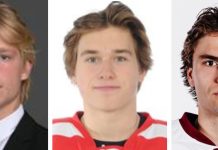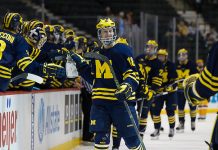The calendar has turned to March, and we’re heading into the home stretch in the race for the Hobey Baker Award. Of course, the fight for conference championships and NCAA tournament berths does tend to take priority — as well it should — but it is worth remembering that the 10 finalists and three “Hobey Hat Trick” members will be announced this month, and that while the 2012 Hobey Baker Award winner won’t be announced until April 6, the vote will take place this month.
And so, this week in the Hobey Watch, it’s time to address a candidate who hasn’t really been given a full discussion in this space yet: Colgate senior forward Austin Smith.
Smith, as you probably know, is the national leader in goals with 34, averaging a goal per game for the regular season. That is one hell of an accomplishment when you think about it, and it should go without saying that he’ll be one of the 10 finalists for the Hobey when those names are announced in a couple of weeks. The question, however, is how much further he’ll go.
When battling for the right to be called college hockey’s top player — although Smith probably isn’t thinking about battling for any more than the ECAC Hockey title — it doesn’t hurt to be the nation’s leading goal-scorer. On the other hand, it also doesn’t help quite as much as you’d expect. Consider this: Part of the speculation surrounding Smith is that he could be the first player in nearly 20 years to score 40 goals in a season, depending on how Colgate’s run in the ECAC Hockey playoffs goes. The last player to eclipse that mark was Dean Fedorchuk, who scored 42 for Alaska (then known as Alaska-Fairbanks) in the 1993-94 season.
There’s a strong possibility that you’re currently asking yourself who Dean Fedorchuk is, and part of the reason that his name isn’t more familiar (besides that he played most of his pro career in Germany) is that he didn’t win the Hobey. That season’s award went to Chris Marinucci. In fact, in the last 13 seasons (that’s how far back national statistics go here on USCHO), only three Hobey winners have finished the season as the national leader in goals: New Hampshire’s Jason Krog in 1999, Colorado College’s Peter Sejna in 2003 and Minnesota-Duluth’s Junior Lessard in 2004.
Of course, looking at historical statistics for these sorts of things can be a bit tricky, since we’re looking at different statistics than the Hobey voters did. For example, former Boston College forward Cam Atkinson finished the 2009-10 season as college hockey’s leading goal-scorer with 30, but six of those came in BC’s four NCAA tournament games. Another Eagles forward, Nathan Gerbe, finished the 2008 season as the national goal-scoring leader, but five of those came during the Eagles’ two wins at the Frozen Four, meaning that when the Hobey voting took place, eventual winner Kevin Porter still led the nation in goals.
There are other factors to consider, as well: 2006-07 goals leader Ted Cook didn’t even crack the top 10 after scoring 32 goals for Niagara, but the Purple Eagles played in the CHA, and only 10 of Cook’s goals game against opponents from the “Big Four” conferences (It also didn’t help that he had a pair of high-scoring linemates in Les Reaney and Sean Bentivoglio, who could have also been considered for a finalist berth). Conference concerns might also explain how 2009 goals leader Jacques Lamoureux of Air Force didn’t make it to the Hobey Hat Trick. On the other hand, having not yet been introduced to college hockey in 2000, I have no recollection of why North Dakota’s Lee Goren didn’t get a finalist nod that year after leading the nation in goals.
The only thing I do know with regards to Goren is that his North Dakota teammate, Jeff Panzer, was a Hobey finalist that year, which is a good reminder of Elliot’s Rule of the Hobey No. 1: No Hobey candidate exists in a vacuum.
Who else is in the field ALWAYS matters. Just look at the 2006 Hobey Hat Trick. I was running the Hobey Watch panel at CSTV back then, and our voters predicted a Hobey Hat Trick that included Denver defenseman Matt Carle, Wisconsin goalie Brian Elliott and Minnesota forward Ryan Potulny. Potulny’s 38 goals that year are the most in recent memory, but when the actual Hat Trick was announced, it was Chris Collins, not Potulny, who joined Carle and Elliott in the Hat Trick.
What happened there? Well, one pattern I’ve noticed is that since there’s been a Hobey Hat Trick, there’s always been a player from an Eastern conference in the mix. The closest thing we’ve had to an all-Western Hobey Hat Trick is 2007, when Air Force’s Eric Ehn (playing in Atlantic Hockey, mind you) joined Ryan Duncan of North Dakota and David Brown of Notre Dame at the presentation ceremony in St. Louis. So, Collins was in, but who would be out? The defenseman with monster numbers who’d won back-to-back NCAA titles in the two previous seasons? The goalie who backstopped Wisconsin to its eventual NCAA title? Or the national leader in goals, who’d just been on the wrong end of one of the biggest upsets in NCAA hockey history?
If there hadn’t been a Carle or an Elliott that season, Potulny might have been in the Hobey Hat Trick. But there they both were, so there he wasn’t.
So, where does all of this leave Austin Smith? Much of that will depend on what he does in the next couple of weeks. At this point, having averaged a goal per game in the regular season, it’s safe to say that he’s earned his spot as a Hobey finalist. After that, it gets tricky, and it makes Colgate’s playoff run extremely important.
Smith has 34 goals. My educated guess is that in order for him to have a real shot at winning the Hobey, at least one of two things needs to happen:
1. Smith needs to reach the 40-goal plateau
2. Colgate needs to reach the NCAA tournament, which probably means winning the ECAC Hockey playoff title.
If both of those things happen, I’d say that Smith has an excellent shot at winning the Hobey. If neither happens, I think it’s “Thanks For Playing” after the finalist round. If one or the other happens, well …
Once again, we come back to Rule No. 1: No candidate exists in a vacuum. I think it’s fair to say that at this point, Jack Connolly of Minnesota-Duluth will be in the Hobey Hat Trick. The other two spots will be filled by a mix of candidates that includes Smith, Maine forward Spencer Abbott, Wisconsin defenseman Justin Schultz and others (Bjugstad, Hunwick, Grosenick, etc.). There are arguments for everyone being considered. Some of those arguments will get stronger or weaker over the course of this month. What happens to which arguments remains to be seen.
What do you think the most likely outcome is for Austin Smith? Do you think Colgate can win ECAC Hockey? Do you agree that the Raiders need to make the NCAA tournament for Smith to have a shot at the Hobey? Let me know what you think below … I’ll be watching.


